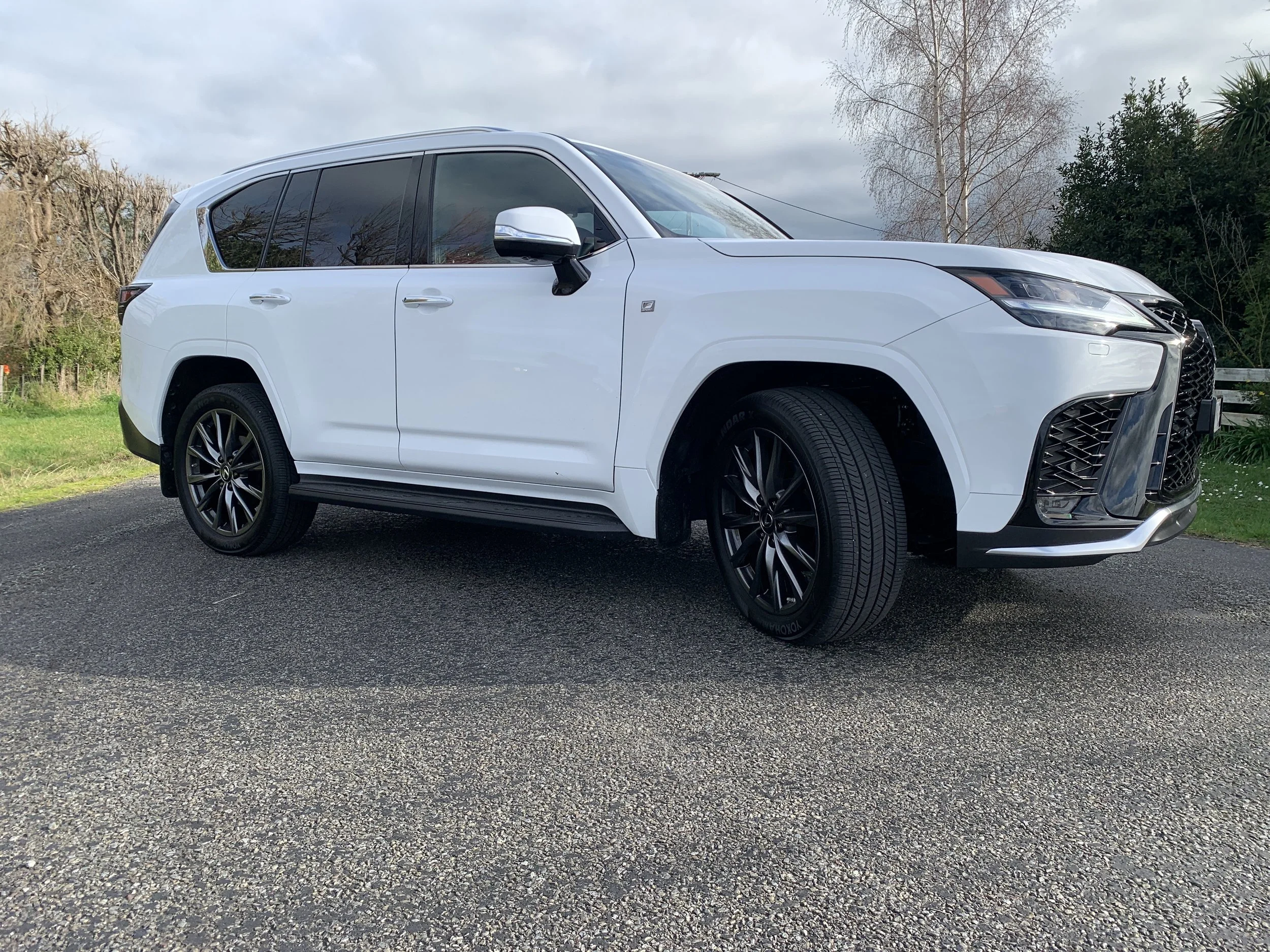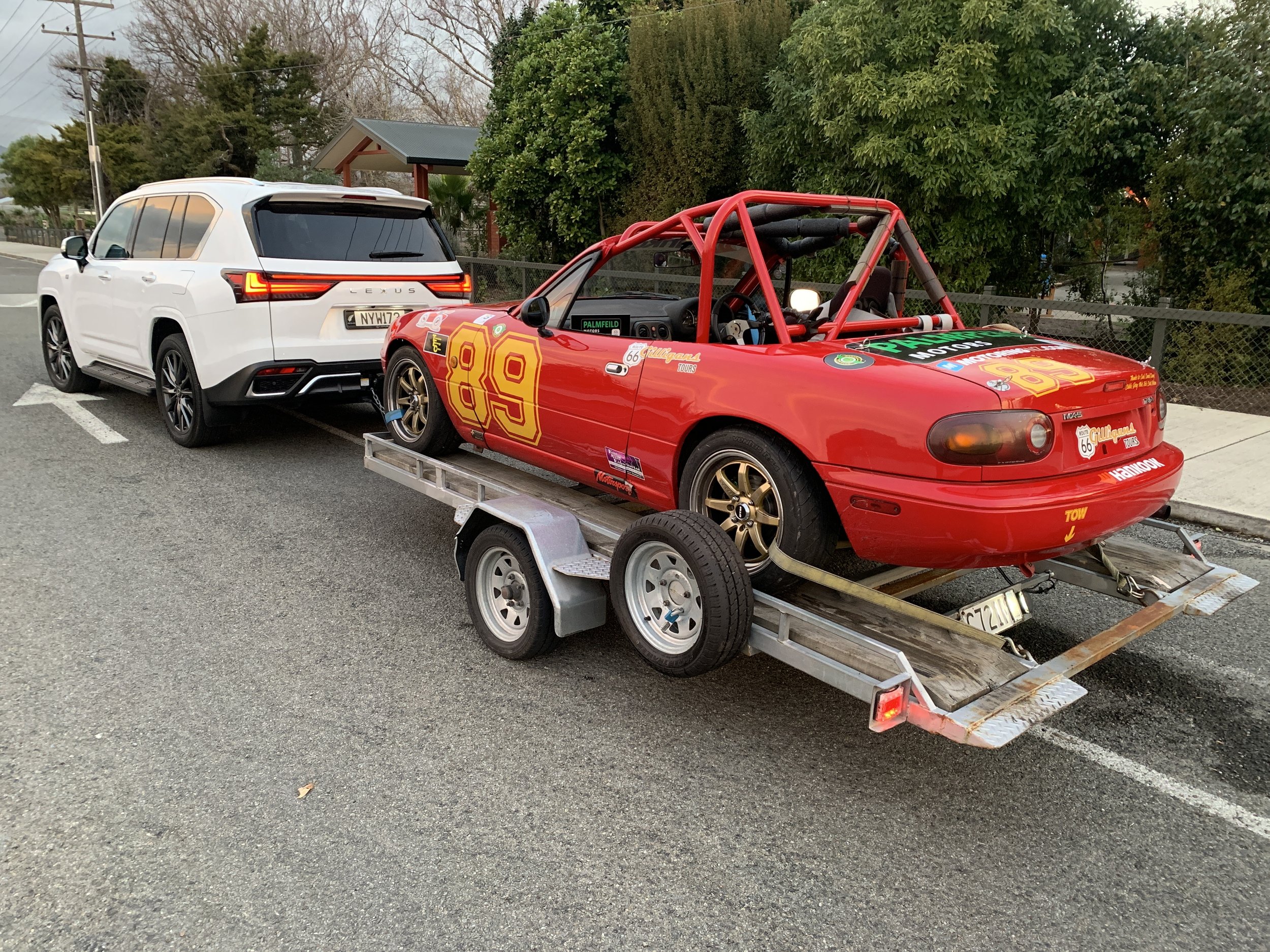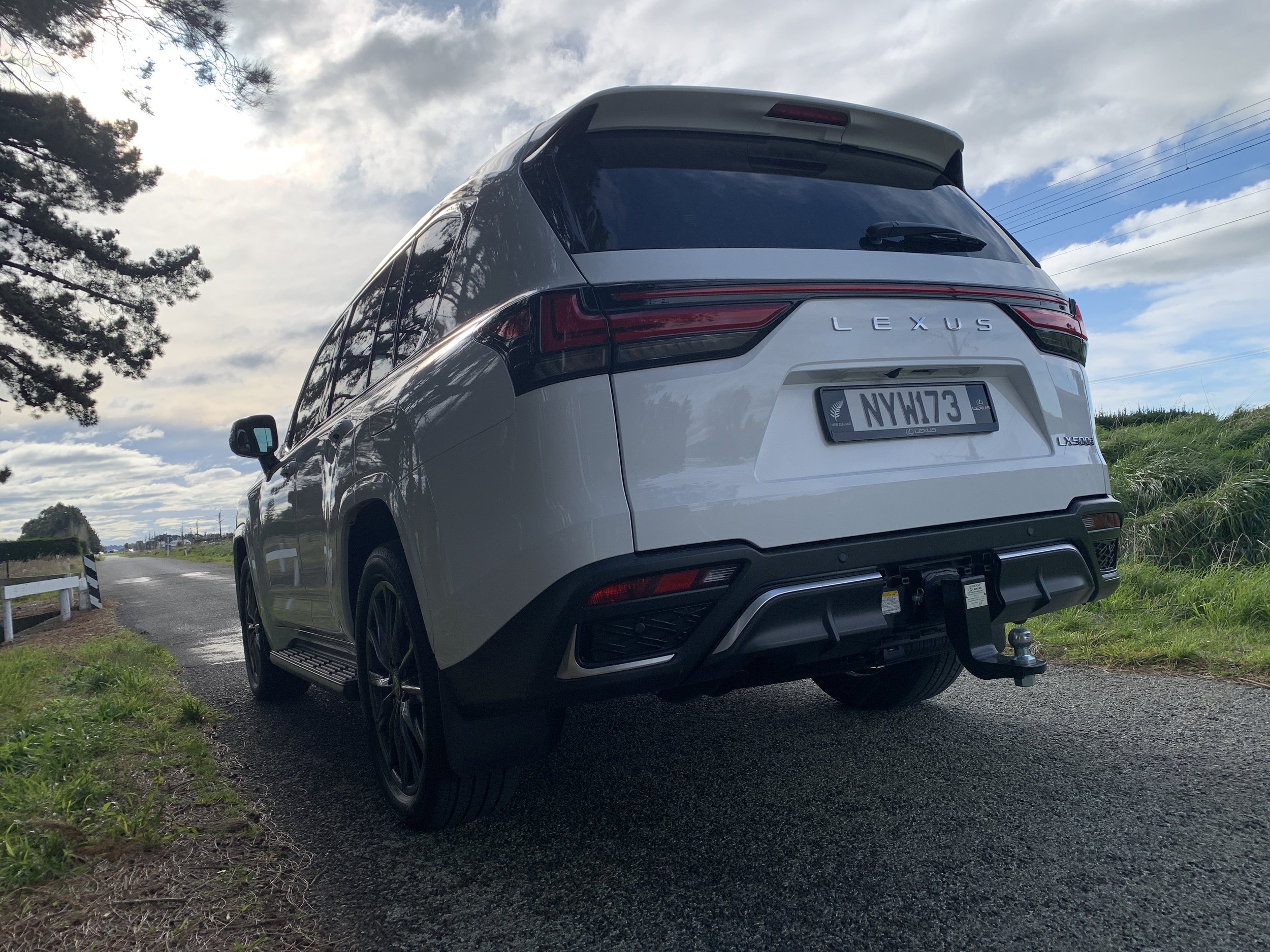Lexus LX500d F-Sport: Hot shoeing with bigfoot
/What difference does a splash of performance enhancement lend to the upscale sibling to the Land Cruiser 300-Series?
Price: $175,900
Powertrain and economy: 3.3-litre turbocharged V6 diesel, 227kW/700Nm, 10-speed manual transmission, AWD, combined economy 10.2L/100km, CO2 268g/km.
Vital statistics: 5100mm long, 1990mm wide, 1895mm high, 2850mm wheelbase, luggage capacity 100-1960 litres, 22-inch alloy wheels.
We like: Build quality, refinement.
Not so much: GR Land Cruiser shows it up.
WHAT’S 5.1 metres long, two metres wide, weighs close to three tonnes and has capability of tackling terrible terrain and coming out trumps?
It’s a Land Cruiser 300-Series, of course; one of the one of the few authentic off-roaders left. It’s also a Lexus LX 500d. Or, at least, it should be.
They have the same powertrain, same platform, same engineering … all the right kit. Double-wishbone front and four-link rear suspension, adaptive variable suspension, downhill crawl control, surface-specific traction modes that work in low- and high-range, diff lockers at both ends. All that stuff that gets the Toyota in the toughest terrain is carried by the Lexus as well, so in theory it’s a good thing made all the better: Along with all that off-road capability comes a bigger dose of premium-ness; notwithstanding the Cruiser is a really upscale car anyway, the idea is that Lexus is to go-to if you intend to pull to red carpet events.
Yet let’s face it, as much as it is clearly the only bent-L badged product in which you’d surely feel comfortable wearing gumboots – and just one of several up to being driven into places that require them – you kinda imagine few if any will be taken into muck. Or even the countryside.
The styling and spec speak lend good reason why Lexus doesn’t advertise its off-road credentials nearly as much. In addition to all the hard-out stuff, it also has a lower ride height, super-big rims shod with rubber that really doesn’t look hugely mud-ready and has lots of luxury upmarket embellishments not likely to stand up well to ultimate punishment.
That doesn’t mean it’s a shirker for toil, but buyers know what they are getting into and what they intend it for. But living the high life isn’t so easy any more; this is a time when, by Government edict via the clean car legislation, the validity of every vehicle is under scrutiny.
Okay, it’s all about emissions, but distributors are about to have to make hard decisions about what to keep and what to drop going forward. Consumers already pay CO2 penalty for having this rig; from next year distributors will, too. But their hit is going to hurt more, so conceivably they’ll be sorting which vehicles over the limit are vital, and which are less so.
The Land Cruiser might conceivably sit on the same safe list as Toyota Hilux; both are bone ide workhorses. As a favourite, in particular, with high country farms, the 300-Series trades on ‘can-do’ credbiloty. But the Lexus? Image of it finding ownership primarily in ‘can but won’t’ ownerships is based on hard evidence. Can anyone, the distributor included, afford to tolerate a toff designed and dedicated to indolent roaming? It needs a proper job, and fast.
Might the F-Sport treatment add any weight to the LX’s resume? Performance-themed SUVs are big business and all the big names of the European scene are playing up large. Is the Land Cruiser/LX eligible for that club? Bulk and build type don’t leave it looking like the kind of vehicle in which you’d run with an Audi Q8 or BMW X5 M, let alone a Lamborghini Urus or Porsche Cayenne. Frankly, it’s never been known to deliver quick acceleration or nimble handling. All the same, there’s probably good potential in sharpening up its step, even just a little.
The formula truly works for the Toyota. Driving the 300 Series GR – for Gazoo Racing – earlier this year was illuminating. It proved somewhat less of a gigantic, rolling vehicular contradiction that you might fear; to point of being surprisingly rewarding.
And now Lexus seems to be having a turn, with this first application of the F-Sport moniker on their beast. Assuming it has the same mettle, then the formula could be even better, given it’s ‘just’ $30k more. Conceivably, is this the same panache in a higher level of plush?
Best understand that this isn’t about performance in a stopwatch sense. This bodyshape is diesel dedicated and while the 3.3-litre V6 now the sole choice engine has more grunt than the V8 that previously inhabited, the emphasis is more on big torque for pulling big loads than on huge power for laying fast take-offs.
So, while it has a decent amount of oomph, and it doesn’t take too much effort to get this enormous rig rolling at a meaningful rate, it’s also true that it feels pretty slow when compared with anything out of Europe. The transmission does a good job of slushing between the gears, but it can take time to react when you need a sudden burst of speed.
Really, the context is more about dynamic demeanour, which in itself is a heck of a challenge. Historically, this has been an SUV without any aspirations of being ‘agile’.
How to break the trend? The LX uses an electric power steering system whereas the ‘Cruiser has rack-and-pinion steering with hydraulic power assistance, with an electric steering actuator so as to allow it an active lane-keeping aid function. The trick feat with the GR Sport’s suspension is that it has disconnecting anti-roll bars. F-Sport uses a torsen limited slip differential but adds performance dampers, a different steering tune, and forged alloy wheels.
The suspension and ride height is 35mm lower, to 200mm, on the Lexus, and the wheelsize is much larger. You won’t find a Land Cruiser riding on factory-provisioned 22-inch rims. Actually, you won’t find another Lexus on these, either.
But if sport is on the label, which is sportier? I’d say it’s the GR. While it ultimately still needed coaxing around corners rather than throwing into them and wasn’t for outright hustling, the ‘Gazoo’ was impressive in delivering less dramatic body lean and more accurate turn-in than you’d usually expect from a Land Cruiser.
Even in its optimal Sport Plus mode, the LX hadn’t the Toyota’s decisiveness. There’s no Nurburgring back story for either, but the LX demanded more circumspection. When it throws its weight around … well, there’s a LOT of weight. It’s not just that. The steering still feels oddly disconnected. You notice that it asks for frequent small corrections to keep the vehicle on a straight path.
Where the Lexus is more, well, Lexus-like is at the other end of the spectrum, in the comfort settings. Let it run in relaxed fashion and you enjoy a cushioned, floaty ride that softens out the majority of bumps.
It’s also genuinely refined. I loved this powertrain’s smoothness and refinement in the GR; but Lexus being Lexus has put in a lot of effort to ensure less roar reaches the cabin. Once upon a time a diesel would have been at odds with the Lexus pursuit of ultimate perfection, but now it hardly sounds diesel-like at all, such is its generally quiet and civil nature.
The way the vehicle is constructed keeps it from being a limo, but it definitely dresses for that role anyway.
Where the LX really tops the Toyota is as you’d expect; with its comfort levels. It’s optimal plush. The leather is beautiful. The seats seem to be more arm chair-like than Toyota’s and, of course, there’s no manual adjustment of anything.
The centrepiece of the interior is the 12.3-inch infotainment screen that towers atop the dashboard. It’s home base for lots of touchscreen operability – for the navigation, the audio control and the surround view monitor - though Lexus also uses a lot of buttons, too, though they are generally laid out with more thought to sensibility than in the Land Cruiser.
The Lexus doesn’t offer much more conveniences than the Toyota. It just upgrades the experience. An example: Lexus has been using Mark Levinson stereos since day dot. This one is a surround set-up with 25 speakers – the highest number ever in a Lexus – including a subwoofer that utilises the body frame. Land Cruiser does it cheap with a 14-speaker JBL.
With the Lexus, too, you get a second 7.0-inch touch display showing the climate control screen and multi-terrain driving programmes; all touch-activated whereas with the Toyota, those functions enable through a switch. Both vehicles use the same rotary dial for driving mode selection.
Lexus uses a voice control system that responds to “Hey Lexus” prompts and also at last picks up Apple CarPlay and Android Auto. A Lexus first is fingerprint authentication through a sensor installed in the centre of the ignition button. The engine will not start unless the fingerprint matches the details supplied for the vehicle. As the test example was going through a lot of hands, this feature had been deactivated.
There’s also a more conventional seven-seat cabin layout now, those rearmost side-mounted chairs of old being dropped for more orthodox forward-fixed types that fold away into the floor when not needed. The middle seats slide forward and back to free up extra space for those sitting right at the back.
There’s plenty of space in the front and middle seats due to the tall roof and boxy shape, but perhaps the back row might only be really comfortable on shorter journeys. There is still a reasonable boot in seven-seat configuration, but if you switch to five you get an impressive space. The cabin is also dotted with deep storage spaces and cubbies.
Starting off with a walkaround, it’s plain that the Lexus design approach is one of embellishment. It has different headlight and running light designs, different front and rear bumpers, different wheels.
The F-Sport is exempted the singular Lexus styling signature of the waterfall grille; LX Limited has this in grand, but utterly grotesque, scale.
Even though the wheel arches and door shapes seem identical to land Cruiser’s, they’re not. The rear-side windows and D-pillars are different shapes. The Lexus not only has more chrome detailing, but the strips are wider. Around the back, the tailgate is the same, but the Lexus one is a different stamping and achieves a full-width tail light bar. It’s almost as if they’re trying to convince consumers they’re different vehicles.
The only Land Cruiser-like exercise the LX was asked to undertake during my tenure was towing my Mazda MX-5 race car to and from a local meeting, with the boot also loaded up with gear, albeit only after I carefully laid down a plastic sheet.
Having 1.2 tonnes on the hook made no difference to the performance; if the engine was even feeling the additional weight, you couldn’t hear it from the highly comfortable, hugely insulated cabin.
A good reason to buy? You know it’s not. A Land Cruiser will do this just as well. You pay less and still get a really decent spec, fit and finish; it’s not as patently luxury but is certainly premium enough. Plus, on the practical side of things, it is just a lot more down to Earth.
Global circumstances mean the LX has become as hard to get as the Land Cruiser. The on-and-off shuttering of Toyota's production facilities in Japan, with major plants suffering frequent closures due to a combination of parts shortages and covid outbreaks, has hindered production of all Toyotas, but the biggest off-roader seems to have been particularly affected. The factory is years behind fulfilling the global order count. Order either today and you won’t expect to have it for at least a year.
By that time, Toyota NZ, of which Lexus is a part, will be deep into its commitment to bring down its CO2 count to meet legislative expectation. The V6 is still one of the higher CO2 contributors in its lineup. Just saying.
There’s talk Lexus is working on a hybrid drivetrain for LX, releasing around 2024. That could quite literally be a life-saver.





















